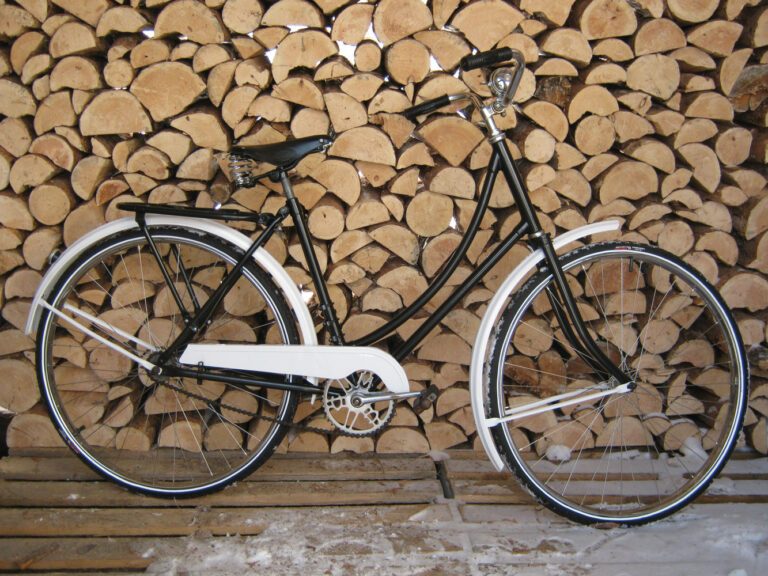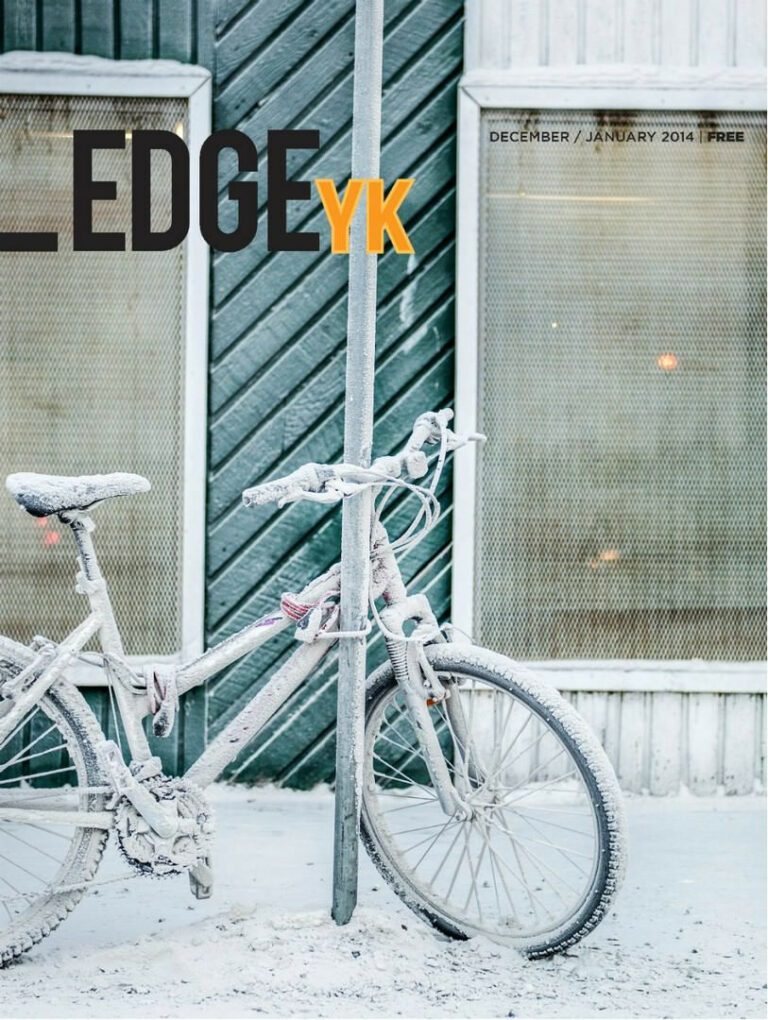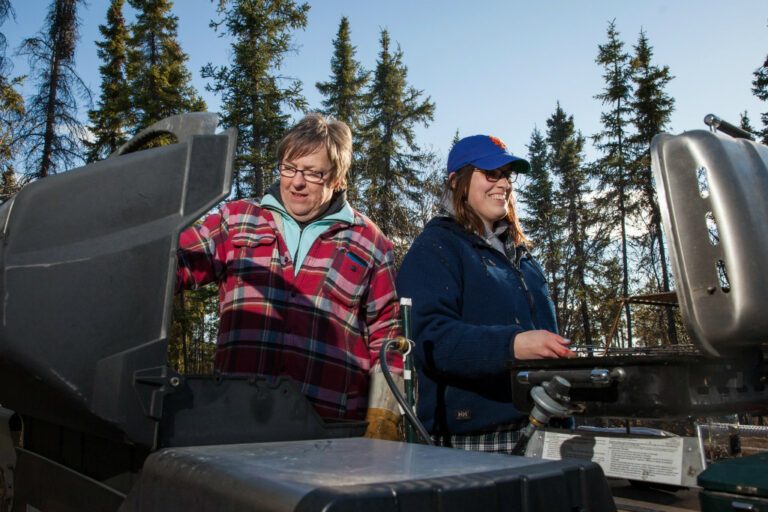Making a rustic birch-tree podium
1: constructed or made in a plain and simple fashion, in particular; made of untrimmed branches or rough timber.
story and photo by Josey Goodin
Walking through the bush with a handsaw in one hand and an evolving vision in my mind, I realize how much I am truly enjoying this quest – this mission to find and transform a piece of nature into a functional work of art that will capture and exude its organic elegance.
Each tree is a potential piece of the puzzle. With every birch, poplar and alder I pass, every twisted root I stumble over, ideas run back and forth through my mind that will eventually take the form of a rustic podium.
A couple weeks prior to my adventure in the woods, I was approached by some friends to help with prep for their upcoming wedding. Of course I was more than happy to oblige. They first asked if I could build some stands to support a ‘canoe bar’ for the reception. Easy, done.
Then, almost as an afterthought, they asked if I could whip together a podium. “Maybe just something simple like a birch log with a top on it,” was the groom-to-be’s concept.
After some consideration, I concluded that if I was going to create something that would be a focal point for 160 people, it should be a little more elaborate. Something rustic-yet-elegant, to capture the spirit of the outdoor ceremony set to take place in scenic Old Town with the natural beauty of Great Slave Lake as the backdrop.
So with a vague concept in mind, a packed lunch and a handsaw in hand, the following week I headed down the Ingraham Trail in search of some deciduous inspiration.
Rummaging through the woods, I am filled with a sense of connectedness and respect for the natural beauty of my surroundings. My creative juices begin to flow.
I stumble across a grey, twisted deadfall poplar with a smooth, polished surface created by years of extreme weather. It would make a fantastic rustic log headboard or frame for a bed. Soon after I find a stand of young willow just begging to become the arched accent of a bent back chair, but I’m searching for a podium.
Around four hours in, and several mosquito bites later, I’ve covered a fair bit of ground. I’ve discovered some great pieces of wood but none quite fit the images conjured in my mind. Then, out of nowhere, like an epiphany, a piece of the puzzle reveals itself to me. Eureka!
Whether by luck or fate, I stumble across a birch tree unquestionably destined to become an integral part of the podium. Its contours remind me of the Swiss alphorns from those old Ricola cough drop commercials. You know the ones.
With some new-found clarity, it takes only another half hour or so to find two similarly bent pieces of birch to complete the puzzle. Satisfied and inspired by what the land has offered me, I pack up my saw and wood and head home to ponder the day and prepare for the next task of transforming my vision into something tangible.
As I play around with the materials I’ve harvested, I try to let the natural curves and details of each piece of wood determine its own destiny. A peeled back strip of the white, husky, outer bark reveals a smooth and deeply vibrant orange inner bark. Perfect!
Exposing this beautiful hidden layer will give the stand an element of rustic refinement worthy of an outdoor wedding ceremony. As I plod away over the next day or so, the three birch alphorns go through a kind of metamorphosis and begin to take the form of what I can only describe as a prehistoric beast spreading its toes. I like it!
Pleased with how the legs have come together, it’s time to work on the top. To keep with the theme, I decide to use a piece of cabinet-grade birch plywood to complement the design. After determining the proper angle and attaching the plywood to the base, I cut out the desired shape, router and sand the edges, and add a quick coat of varnish. For a final accent, I peel and split a small birch branch to attach to the surface as the lip of my podium. Voila! Mission complete.
With a touch of inspiration and a few days’ work, I’ve created a one-of-a-kind memorable gift for my friends’ special day.
The key to working with rustic furniture is finding beauty in imperfection. One of the great things about using raw materials is that no two pieces are ever the same. No matter what you have planned or envisioned, each piece has its own personality that will shine through in the finished product.
Creating something rustic, whether a functional piece of furniture or a decorative work of art, is about being in the right frame of mind. It doesn’t take a master woodworker or an acclaimed artist to create something unique and beautiful. Once you open yourself to what your surroundings have to offer, the possibilities are limited only by your imagination.
Tips on making your own piece of furniture
Whether you’ve made something in the past, or you’re newly inspired to head out to the bush and put your imagination to work, there are some things that can make or break your rustic furniture making experience. Here are a few tips to keep in mind:
• Use a good handsaw: I use a Japanese crosscut saw from Lee Valley that is great for cutting medium to small trees and making clean-finished cuts. Most often this is the only saw I use. I also keep a ratcheting lopper in my arsenal to cut smaller trees and branches. These work especially well for cutting willow shoots for bent back chairs.
• Check for bugs: Oftentimes deadfall or dying trees have been burrowed through by ants or termites and should be avoided. Loose areas of bark, small holes in the tree and little piles of sawdust are all signs insects have discovered that perfect piece of wood before you.
• Make it sturdy: I like to use a cordless drill to pre-drill then screw together most of the furniture I make. Although screws tend to be a bit more visible than nails, they secure the pieces very well. With a bit more time and patience, it’s fun to try different methods of joinery such as mortise and tenon or lashings. However it’s assembled, you don’t want to see your creation tip over or fall apart as soon as someone touches it!
• Use it or lose it: Unless you are purposely drying your wood to avoid it cracking or shrinking once it has been assembled, use it while it is still workable. If you want to peel the outer bark off of a piece of birch, for example, it is best done soon after the tree has been cut. Otherwise, the bark will become too dry and brittle. Willow for bent back chairs is also best used while green as it is much more pliable for bending. If anything, the odd crack that appears will add to the character of the piece as it ages. You may want to think about drying the wood first, if you plan on using mortise and tenon joints to avoid shrinkage, which can lead to loosening joints.
• Maintain it: By keeping rustic furniture under cover and away from the elements, it can be enjoyed for years, or even decades. It is also a good idea to retighten screws that may have loosened from drying or being moved around over time. One of the first chairs I ever made is as sturdy today as it was when I made it more than 15 years ago.







